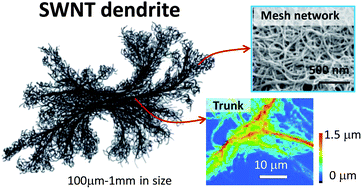This month sees the following Journal of Materials Chemistry B articles that are in the top ten most accessed for January:
Individual inorganic nanoparticles: preparation, functionalization and in vitro biomedical diagnostic applications
R. Ladj , A. Bitar , M. Eissa , Y. Mugnier , R. Le Dantec , H. Fessi and A. Elaissari
J. Mater. Chem. B, 2013,1, 1381-1396
DOI: 10.1039/C2TB00301E
Graphene-incorporated chitosan substrata for adhesion and differentiation of human mesenchymal stem cells
Jangho Kim , Yang-Rae Kim , Yeonju Kim , Ki Taek Lim , Hoon Seonwoo , Subeom Park , Sung-Pyo Cho , Byung Hee Hong , Pill-Hoon Choung , Taek Dong Chung , Yun-Hoon Choung and Jong Hoon Chung
J. Mater. Chem. B, 2013,1, 933-938
DOI: 10.1039/C2TB00274D
Carbon nanostructures as multi-functional drug delivery platforms
Rafael G. Mendes , Alicja Bachmatiuk , Bernd Büchner , Gianaurelio Cuniberti and Mark H. Rümmeli
J. Mater. Chem. B, 2013,1, 401-428
DOI: 10.1039/C2TB00085G
Magnetic nanocomplexes and the physiological challenges associated with their use for cancer imaging and therapy
Eunjung Kim , Kwangyeol Lee , Yong-Min Huh and Seungjoo Haam
J. Mater. Chem. B, 2013,1, 729-739
DOI: 10.1039/C2TB00294A
One-step preparation of nitrogen-doped graphene quantum dots from oxidized debris of graphene oxide
Chaofan Hu , Yingliang Liu , Yunhua Yang , Jianghu Cui , Zirong Huang , Yaling Wang , Lufeng Yang , Haibo Wang , Yong Xiao and Jianhua Rong
J. Mater. Chem. B, 2013,1, 39-42
DOI: 10.1039/C2TB00189F
Doxorubicin conjugated gold nanorods: a sustained drug delivery carrier for improved anticancer therapy
Rajiu Venkatesan , Arunkumar Pichaimani , Kalpana Hari , Preetham Kumar Balasubramanian , Jeganathan Kulandaivel and Kumpati Premkumar
J. Mater. Chem. B, 2013,1, 1010-1018
DOI: 10.1039/C2TB00078D
Biotin-decorated fluorescent silica nanoparticles with aggregation-induced emission characteristics: fabrication, cytotoxicity and biological applications
Min Li , Jacky W. Y. Lam , Faisal Mahtab , Sijie Chen , Weijie Zhang , Yuning Hong , Jun Xiong , Qichang Zheng and Ben Zhong Tang
J. Mater. Chem. B, 2013,1, 676-684
DOI: 10.1039/C2TB00155A
Encapsulating bioactive materials in sonochemically produced micro- and nano-spheres
Olga Grinberg , Ulyana Shimanovich and Aharon Gedanken
J. Mater. Chem. B, 2013,1, 595-605
DOI: 10.1039/C2TB00006G
Preparation and application of thionin-bridged graphene–gold nanoparticle nanohybrids
Zhijun Zhu , Lan Ma , Min Su , Dianjun Liu and Zhenxin Wang
J. Mater. Chem. B, 2013,1, 1432-1438
DOI: 10.1039/C2TB00117A
Novel trypsin-FITC@MOF bioreactor efficiently catalyzes protein digestion
Wan-Ling Liu , Sheng-Han Lo , Brenda Singco , Chun-Chuen Yang , Hsi-Ya Huang and Chia-Her Lin
J. Mater. Chem. B, 2013,1, 928-932
DOI: 10.1039/C3TB00257H
Why not take a look at the articles today and blog your thoughts and comments below.
Fancy submitting an article to Journal of Materials Chemistry B? Then why not submit to us today!


















